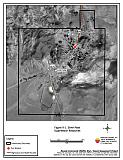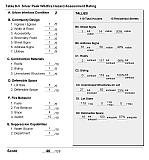9.0 Silver Peak
9.1 Risk and Hazard Assessment
Silver Peak is located in central Esmeralda County at the terminus of Nevada State Route 265, off of US Highway 6. Silver Peak is situated along the edge of an alkali flat at about 4,700 feet elevation. Figure 9-1 depicts the community boundary. The community hazard assessment classified Silver Peak to the Moderate Hazard category (46 points). A summary of the factors that contributed to the hazard rating is included in Table 9-3. The factors that most influenced the hazard score for Silver Peak were related to potential hazardous fire behavior from slope and aspect affects on the west side of the community, limited suppression resources from the volunteer fire department, and high density housing.
9.1.1 Community Design
The wildland-urban interface area around Silver Peak can best be characterized as intermixed. Structures are scattered throughout the wildland area and there is no clear line of demarcation between wildland fuels and the residential structures in the community. All of the residences are on lots of less than one acre.
- Roads: Nevada State Route 265 is the main transportation route through Silver Peak. The highway is paved and at least 24 feet in width.
- Signage: Street signs were easily visible throughout the entire community. Addresses were visible on only about half of the homes.
- Utilities: Utilities are all above ground. Power lines have been properly maintained minimizing the possibility that arcing may start fires in nearby vegetation.
9.1.2 Construction Materials
All of the homes in the interface were built with non-combustible siding materials. Only two of the homes did not have fire resistant roofing materials such as composition, tile, or metal. Twenty-seven of the 119 homes observed had unenclosed balconies, porches, decks or other architectural features that provide areas where sparks and embers could be trapped, smolder, ignite, and rapidly spread fire to the home.
9.1.3 Defensible Space
Almost ninety percent of the homes met the minimum recommended defensible space guidelines for landscaping to help protect the home from damage or loss during a wildfire. The defensible space requirement is based on vegetation conditions and slope and is further explained in the Defensible Space Guidelines in Appendix E.
9.1.4 Suppression Capabilities
Wildfire Protection Resources
Silver Peak is served by the Silver Peak Volunteer Fire Department, which, at the time that interviews were conducted for this report was comprised of eight members. Table 9-1 lists the types of wildfire resources, cooperating partners, and equipment available to Silver Peak in the event of a reported wildland fire. Additional cooperating wildfire suppression agencies, equipment, and resources are listed in Table 4-2.
| Type of Equipment | Amount of Equipment | Cooperating Partner (Resource Location) |
|---|---|---|
| Engine Type 2 Engine Type 3 Engine Type 6 |
1 1 1 |
Silver Peak Volunteer Fire Department (Silver Peak) |
| Source: Personal communication with Chief Frank Baker, Silver Peak VFD. | ||
Water Sources and Infrastructure
Water availability for fire suppression in Silver Peak includes:
- Community wells,
- 500 gpm hydrants within 1,000 feet of structures,
- A water storage tank with 450,000-gallon capacity, and
- A community swimming pool that could potentially be used as a helicopter dip spot.
The water system by gravity flow and electrical pumps with an emergency backup generator.
Detection and Communication
Fires in Silver Peak are reported through 911 calls to the Esmeralda County Sheriff’s Office in Goldfield. Fires are communicated to fire response personnel through Esmeralda County Sheriff’s Office Emergency Dispatch using radios and pagers. The Esmeralda County Sheriff’s Office and the Volunteer Fire Departments have access to the state mutual aid frequencies. The radio system is compatible with neighboring agencies. There are gaps in radio coverage by State Highway 265.
Fire Protection Personnel Qualifications
All volunteer firefighters are trained to the State of Nevada Fire Marshal Firefighter I and II qualifications. The Silver Peak VFD does not utilize the Red Card system for individual qualifications. Red Card certification is part of a fire qualifications management system used by many state and all federal wildland fire management agencies. This certification indicates that an individual is qualified to fight wildland fires.
Work Load
The Silver Peak VFD responded to 31 calls in 2003. None of these were wildland/brush fire calls.
Financial Support
Financial support for the Silver Peak Volunteer Fire Department comes from the Esmeralda County General Fund.
Community Preparedness
Silver Peak is included in the Esmeralda County Local Emergency Planning Committee plan, which includes hazardous material, a disaster plan, and an emergency evacuation plan for hazardous materials incidents. The Silver Peak Fire Chief is authorized to activate the evacuation plan, and the Volunteer Fire Department has it’s own pre-attack plan. The Silver Peak VFD reviews community development plans but does not have a brush clearance program.
The Chemtel Foot Mine located near Silver Peak has a 20,000 gallon propane tank. The company has an onsite detection and suppression system for leaks and other hazards.
9.1.5 Factors Affecting Fire Behavior
Vegetative fuel loading in the Silver Peak interface area is classified as light. It is estimated to be less than one ton per acre. The terrain is fairly flat with a south aspect. Fuels in the community consist primarily of greasewood, prickly pear cactus, and some cholla cactus. There is no horizontal or vertical continuity in the fuel bed. There is no significant wind pattern. Overall, the fuel hazard was rated low for the community of Silver Peak.
9.1.6 Fire Behavior Worst Case Scenario
A worst-case wildfire scenario was not described for Silver Peak. The community lies between an alkali flat and a rock mountain and there is no fuel continuity to carry a wildfire into structures. There may be a risk of fire spreading through the community from a structure fire.
9.1.7 Ignition Risk Assessment
Silver Peak was determined to have a low ignition risk rating. There is some history of wildfire ignition to the west of Silver Peak, but no significant record of wildfire activity (see Figure 3-2).
9.2 Bureau of Land Management Site Assessment and Recommendations
The BLM Battle Mountain Field Office completed a site assessment for Silver Peak in March 2003. The assessment team found a very low potential for a catastrophic wildfire in the area due to sparse fuels with no horizontal or vertical continuity to carry a wildfire. The team recommended public education regarding defensible space. The RCI project team concurs with these findings.
9.3 Risk and Hazard Reduction Recommendations and Responsibilities
9.3.1 Defensible Space Treatments
Defensible space treatments are an essential first line of defense for residential structures. The goal of the treatments is to significantly reduce or remove flammable vegetation within a prescribed distance form structures. (Refer to Appendix E for the recommended defensible space area). Defensible space reduces the fire intensity and improves firefighter and homeowner chances for successfully defending a structure against oncoming wildfire.
Property Owner Responsibilities
- Remove, reduce, and replace vegetation around homes and outbuildings according to guidelines provided in Appendix E. This area should be kept:
- Lean: There are only small amounts of flammable vegetation.
- Clean: There is no accumulation of dead vegetation or other flammable material including woodpiles.
- Green: Existing plants are healthy and green during the fire season. Irrigate all trees and large shrubs in close proximity to structures to increase their fire resiliency. This is especially important during drought conditions.
- Immediately remove cleared vegetation to an approved disposal site. This material dries quickly and poses a fire risk if left on site.
- Keep the area beneath unenclosed porches and decks free of accumulated vegetation or other flammable debris. Screen or enclose these areas where possible.
- Create a firebreak of bare ground or gravel for 100 feet around hay and equipment storage areas. Because it is dried plant material, stacked or baled hay is vulnerable to ignitions, as much from internal combustion as from outside sources.
- Plant fire-resistant vegetation in the defensible space area around residential structures and outbuildings. This will enhance fire abatement, especially important in rural areas where water sources are limited or distant.
- Clear a minimum ten-foot area around fuel tanks.
- Irrigate and prune trees and shrubs in close proximity to structures. This will increase their fire resiliency especially during drought conditions.
- Mow or remove brush growing against wood fences in the community.
- Board up or remove abandoned trailers and other structures to prevent unwanted ignition from sparks or firebrands.
- Install spark arrestors on chimneys.
9.3.2 Public Education
Silver Peak Volunteer Fire Department Responsibilities
- Distribute copies of the publication “Living With Fire” to all property owners. This publication is available free of charge from the University of Nevada Cooperative Extension.
9.3.3 Equipment and Training
Silver Peak Volunteer Fire Department Responsibilities
- Meet annually with the Bureau of Land Management to discuss their pre-attack plans for the community.
- Require Basic Wildland Firefighter training for all volunteer firefighters.
Bureau of Land Management
- Provide wildland firefighting training to meet the minimum standards for Red Card qualifications including Wildland Safety Training and fire shelter use.
| Responsible Party | Recommended Treatments | Recommendation Description |
|---|---|---|
| Property Owners | Defensible Space | Remove, reduce, and replace vegetation around homes according to the defensible space guidelines provided in Appendix E. Maintain this defensible space annually. Mow or otherwise remove vegetation growing or accumulated along fences. Install spark arresters on chimneys. Remove or board up abandoned trailers or other structures to prevent sparks entering and igniting the structure. |
| Silver Peak Volunteer Fire Department | Public Education | Distribute copies of the publication “Living With Fire” to all property owners. |
| Equipment and Training | Meet annually with the BLM to discuss their pre-attack plans for the community. Require Basic Wildland Firefighter training for all volunteer firefighters. |
|
| Bureau of Land Management | Equipment and Training | Provide Basic Wildland Firefighter Training to volunteers including safety and deployment of fire shelters. |
Figure 9-1Silver Peak Suppression Resources |
 |
Table 9-3Silver Peak Wildfire Hazard Rating Summary |
 |
